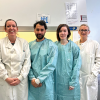Scientists have discovered that cancerous cells in an aggressive type of childhood brain tumour work together to infiltrate the brain.

The researchers investigated a type of childhood brain tumour called diffuse intrinsic pontine glioma (DIPG).
They analysed its ability to leave the brain stem and send cancer cells to invade the rest of the brain.
DIPG is incredibly difficult to treat and nearly all children with this type of cancer die within two years.
The researchers used donations of biopsy tissue and the brains of children who had died as a consequence of DIPG.
They found that DIPGs are heterogenous, which enables the cells to “work” together to leave the original tumour and travel into the brain. The scientists say this shows a multi-pronged attack is likely to be necessary for treatment.
Professor Chris Jones, who led the study, said: “This is the first time we’ve observed this sort of interaction between different tumour cells in DIPG.
“The idea that the cells are working together to make the disease grow and become aggressive is new and surprising.”
Image credit | iStock




